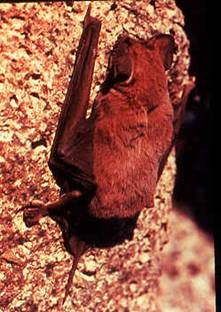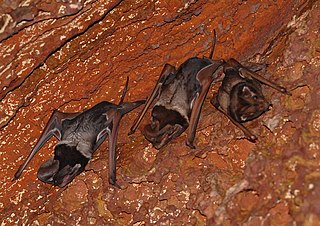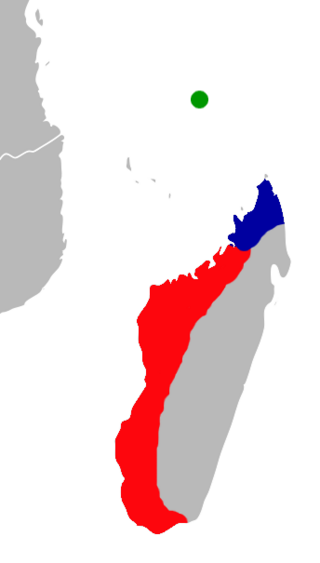
The Molossidae, or free-tailed bats, are a family of bats within the order Chiroptera. The Molossidae is the fourth-largest family of bats, containing about 110 species as of 2012. They are generally quite robust, and consist of many strong-flying forms with relatively long and narrow wings with wrinkled lips shared through their genus. Their strong flying form allows them to fly 60 miles per hour using tail winds and at altitudes over 10,000 feet. This makes them unique among bats, as they are the only bat family that withstands the elevation. They are widespread, being found on every continent except Antarctica. They are typically found in caves, abandoned mines, or tunnels.

Ankarana Special Reserve is a protected area in northern Madagascar created in 1956. It is a small, partially vegetated plateau composed of 150-million-year-old middle Jurassic limestone. With an average annual rainfall of about 2,000 millimetres (79 in), the underlying rocks have been eroded to produce caves and feed subterranean rivers—a karst topography. The rugged relief and the dense vegetation have helped protect the region from human intrusion.

The Madagascar dry deciduous forests represent a tropical dry forest ecoregion situated in the western and northern part of Madagascar. The area has high numbers of endemic plant and animal species but has suffered large-scale clearance for agriculture. They are among the world's richest and most distinctive dry forests and included in the Global 200 ecoregions by the World Wide Fund. The area is also home to distinctive limestone karst formations known as tsingy, including the World Heritage Site of Bemaraha.

The northern rufous mouse lemur, northern brown mouse lemur, or Tavaratra mouse lemur is found in northern Madagascar from the Ankarana Special Reserve in the west to the Manambato River in the northeast, and up to the Irodo River in the north of the Analamerana Special Reserve. The complete distribution range of M. tavaratra is still to be defined as some areas surrounding the described distribution have not been visited yet. For example, M. tavaratra has been reported to possibly occur from the Irodo up to the Montagne des Français. Its known distribution cover four protected areas – the Ankarana Special Reserve, and the Analamerana Special Reserve both managed by Madagascar National Parks, the Loky-Manambato protected area (Daraina), and the Andavakoeira-Andrafiamena protected area, both Managed by the NGO Fanamby

The Natal free-tailed bat is a species of bat in the family Molossidae, the free-tailed bats. It is endemic to the island of Mauritius. It is known from fewer than five locations in its range, but it is common at a few sites. It roosts in caves, and it is considered to be an endangered species due to disturbance of its cave habitat.

The Midas free-tailed bat is a species of bat scientifically classified in the order Chiroptera and the family Molossidae. It is distributed from western Africa to Saudi Arabia and further south. Its natural habitats are dry savanna, moist savanna, woodlands and hot deserts. The more southern are also known to live around large rivers or the swamps.

Otomops is a genus of bat in the family Molossidae. Molecular sequence data supports it as a monophyletic taxon, although not a number of other molossid genera.

The Madagascan rousette or Madagascar rousette, is a species of megabat in the family Pteropodidae endemic to Madagascar. Its natural habitat is subtropical or tropical dry forests.

The Egyptian free-tailed bat, also known as Egyptian guano bat or Egyptian nyctinome, is a species of bat in the family Molossidae.

Grandidier's trident bat is a species of bat in the family Hipposideridae endemic to Madagascar. It was formerly assigned to the genus Triaenops, but is now placed in the separate genus Paratriaenops.

Wroughton's free-tailed bat is a free-tailed bat formerly considered to be confined to the Western Ghats area of India, though it has also recently been discovered in northeast India and in a remote part of Cambodia. It is classified as a Data Deficient species as little is known about their habitat, ecology, or foraging range.

Miniopterus griveaudi is a bat in the genus Miniopterus found on Grande Comore and Anjouan in the Comoros and in northern and western Madagascar. First described in 1959 from Grande Comore as a subspecies of the mainland African M. minor, it was later placed with the Malagasy M. manavi. However, morphological and molecular studies published in 2008 and 2009 indicated that M. manavi as then defined contained five distinct, unrelated species, and M. griveaudi was redefined as a species occurring on both Madagascar and the Comoros.

Commerson's roundleaf bat, also known as Commerson's leaf-nosed bat, is a species of bat endemic to Madagascar. It is named after French naturalist Philibert Commerson (1727-1773). Bat populations of Africa or São Tomé and Príncipe formerly considered part of this species are now classified separately as M. gigas, M. thomensis or M. vattatus, while one from Madagascar was split off to become M. cryptovalorona. It was formerly placed in the genus Hipposideros, but moved to the resurrected Macronycteris in 2017 on the basis of molecular evidence.

Chaerephon jobimena, commonly known as the black and red free-tailed bat, is a species of bat in the family Molossidae. It is endemic to western Madagascar. With a forearm length of 45 to 48 mm, C. jobimena is somewhat larger than other Malagasy bats assigned to Chaerephon, but similar in size to Tadarida aegyptiaca.
Chaerephon atsinanana is a free-tailed bat found on Madagascar. It was considered a subspecies of the little free-tailed bat until 2010. During the day, they are known to roost in man-made structures such as the roofs or attics of buildings.

Harrison's large-eared giant mastiff bat is a species of bat found in Northeast Africa and the Arabian Peninsula. It was described as a new species in 2015. The IUCN evaluates it as a vulnerable species.
The Madagascar sheath-tailed bat is a species of sac-winged bat found in Madagascar.

The western sheath-tailed bat is a species of sac-winged bat found in Madagascar.
















